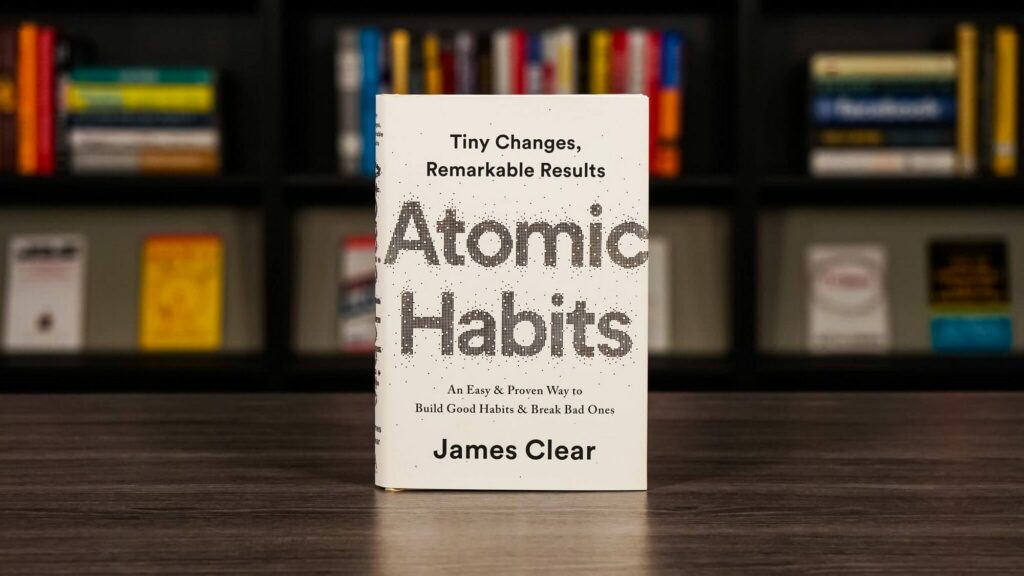Embracing Vulnerability: Who is Brené Brown

Brené Brown is a renowned researcher, author, and public speaker whose work focuses on vulnerability, shame, and courage. With a unique blend of academic rigor and personal storytelling, she has transformed the landscape of self-help literature and inspired countless individuals to embrace their imperfections and lead more authentic lives.
Beginner’s Guide to Building Passive Income in the Digital Era

Building passive income streams in the digital world is not only possible, it’s becoming increasingly accessible. From affiliate marketing and digital products to investing and rentals, there are countless ways to generate income without trading your time for money.
Rediscovering Spontaneity: Why I Stopped Tracking My Habits

In recent years, habit tracking has become an increasingly popular trend, with apps, specialized journals, and techniques aimed at monitoring every aspect of our daily lives. The idea behind this approach is that constant monitoring of habits can lead to a more organized, productive, and satisfying life.
Ready to Blog Your Way to Success?

Have you ever dreamt of turning your knowledge and passion into a profitable online venture? Look no further than blogging! It’s a fantastic option for introverts and anyone who enjoys working independently. Plus, the potential for passive income through affiliate marketing and other strategies is a major perk.
Why You Should Read “Atomic Habits”

Have you ever felt stuck in a loop of unproductive habits, yearning for positive change? If so, James Clear’s “Atomic Habits” is your beacon of hope. This book isn’t just another self-help manual; it’s a roadmap to personal transformation. Buckle up, because I’m about to give you ten compelling reasons why you should dive into this gem.
The self-made man: a myth to debunk

The self-made man is a figure who embodies the dream of those who want to achieve success starting from nothing, without the help of anyone. He…
Ikigai: The Art of Living with Passion and Purpose

Explore the transformative concept of Ikigai and uncover the secrets to a fulfilling life. Delve into expert insights, recommended readings, and practical tips, guiding you on a profound journey of self-discovery.
Carol Dweck’s Growth Mindset Theory

Carol Dweck’s Growth Mindset Theory AI Art by Ermal Alibali In today’s dynamic and ever-changing world, the concept of success is undergoing a profound transformation. At the forefront of this shift is the pioneering work of psychologist Carol Dweck and her groundbreaking theory of the Growth Mindset. The Power of the Mindset Success, in both personal and professional spheres, has long been a subject of fascination and pursuit. For decades, scholars, leaders, and individuals alike have sought to understand the underlying principles that drive achievement and excellence. Carol Dweck, a renowned psychologist and professor at Stanford University, has made a substantial contribution to this discourse with her theory of the “growth mindset.” In this article, I will explore the life and work of Carol Dweck, examine the fundamental tenets of the growth mindset theory, dissect the four key ingredients that fuel its transformative power, and consider the ongoing relevance of Dweck’s groundbreaking insights. Who is Carol Dweck? Before we dive into the depths of her theory, it’s essential to understand the person behind it. Carol S. Dweck is a distinguished psychologist known for her extensive research on motivation, achievement, and personality. She was born on October 17, 1946, in New York City, and her academic journey has been nothing short of remarkable. Early Life and Academic Journey Carol Dweck’s academic path was marked by a relentless curiosity about human potential. She completed her undergraduate studies at Barnard College and then pursued her Ph.D. in psychology at Yale University, under the guidance of renowned psychologist Donald T. Campbell. Her early work focused on the intersection of achievement and self-conceptions, foreshadowing the groundbreaking research she would later undertake. The Birth of the Growth Mindset Dweck’s fascination with achievement and success led her to conduct extensive research on the beliefs people hold about their abilities and intelligence. Through years of empirical investigation, she crystallized her findings into the concept of mindset, which she introduced to the world in her influential book, “Mindset: The New Psychology of Success” published in 2006. Carol Dweck’s Theory Central to Carol Dweck’s work is the concept of mindset—a belief system that shapes how individuals perceive themselves and their potential. Dweck identifies two primary mindsets that profoundly impact one’s approach to learning, challenges, and ultimately, success: Fixed Mindset: Individuals with a fixed mindset perceive their abilities, intelligence, and talents as innate traits, unchangeable and predetermined. They tend to avoid challenges, fearing failure, and often view effort as futile because they believe that success is primarily determined by their inherent abilities. Growth Mindset: In stark contrast, individuals with a growth mindset believe that their abilities and intelligence can be developed and enhanced through dedication, learning, and perseverance. They embrace challenges as opportunities to learn, persist in the face of setbacks, and see effort as the path to mastery and success. Dweck’s groundbreaking theory has profound implications for individuals, organizations, and society as a whole. It challenges the conventional wisdom that talent alone determines success and posits that one’s beliefs about their abilities are equally—if not more—significant. The Four Key Ingredients to a Growth Mindset The growth mindset is not merely an abstract concept; it is a practical framework that can be cultivated and applied to drive personal and professional excellence. To harness the transformative power of the growth mindset, one must understand its four key ingredients: Ingredient 1: Embracing Challenges Individuals with a growth mindset see challenges as opportunities for growth and learning. They willingly step outside their comfort zones, tackle new and difficult tasks, and view difficulties as chances to improve. In the business world, this translates to a workforce that welcomes innovation, adapts to change, and constantly seeks ways to elevate performance. Ingredient 2: Persisting in the Face of Setbacks Resilience is a hallmark of the growth mindset. Instead of succumbing to failure or adversity, those with a growth mindset persevere. They understand that setbacks are not indicators of their inherent inadequacy but rather part of the learning process. In organizations, this resilience fosters a culture of determination, where employees bounce back stronger from setbacks, driving progress and innovation. Ingredient 3: Effort as the Path to Mastery Effort is seen as a necessary and fulfilling part of the journey toward mastery in a growth mindset. Individuals are willing to invest the time and energy required to achieve their goals. In the corporate world, this translates to a workforce that is committed to continuous improvement, striving for excellence in every task and project. Ingredient 4: Learning from Criticism Constructive feedback and criticism are embraced by individuals with a growth mindset. They see feedback as a valuable tool for personal and professional growth, understanding that it can help them become better at what they do. Within organizations, this attitude fosters a culture of feedback, where employees actively seek and provide input, leading to improved performance and innovation. Carol Dweck’s Ongoing Work As of my last knowledge update in September 2021, Carol Dweck continued her work as a professor at Stanford University, where she actively researched and promoted the concept of the growth mindset. However, her influence extended far beyond the walls of academia. Dweck’s theory had found its way into schools, boardrooms, and leadership development programs, sparking a movement towards a more adaptive and resilient approach to learning and achievement. Beliefs of a Growth Mindset At the core of the growth mindset are beliefs that drive individuals to reach their fullest potential. These beliefs include: Belief 1: Potential for Development Individuals with a growth mindset believe that their abilities and intelligence are not fixed but can be developed with dedication and effort. This belief is the foundation upon which the growth mindset is built. Belief 2: Embracing Challenges A growth mindset involves viewing challenges as opportunities for growth and learning. This belief encourages individuals to seek out new and challenging experiences, pushing the boundaries of their capabilities. Belief 3: Persistence Persistence is a natural outgrowth of the growth mindset. Those who embrace this mindset understand that setbacks are part
Unlocking Success and Fulfillment: The Transformative Power of Stillness in a Chaotic World

Unlocking Success and Fulfillment: The Transformative Power of Stillness in a Chaotic World AI Art by Ermal Alibali In the relentless pursuit of success and productivity, we often overlook the immense power of stillness. In his profound work, “Stillness is the Key,” renowned author Ryan Holiday offers not just a book but a guide to achieving clarity, tranquility, and unparalleled success in an increasingly chaotic world. In this article, I will explore the essence of this modern classic, shedding light on why you should read it, the author’s background, key takeaways, and its undeniable relevance in the realms of business and personal development. Navigating the Storm with Stillness Have you ever found yourself drowning in the noise of the modern world? Constant connectivity, overflowing inboxes, and the never-ending hustle can leave us feeling overwhelmed and disconnected from our true selves. Amid this chaos, Ryan Holiday‘s “Stillness is the Key” emerges as a beacon of hope, guiding us towards inner peace, improved decision-making, and unparalleled productivity. Who is Ryan Holiday? Before we delve into the profound insights of “Stillness is the Key” let’s take a moment to acquaint ourselves with the author, Ryan Holiday. As a prolific author, marketing strategist, and philosopher, Ryan Holiday has earned widespread recognition for his unique ability to bridge the wisdom of ancient philosophy with the challenges of the modern world. His previous bestsellers, including “The Obstacle Is The Way” and “Ego Is The Enemy” have established him as a thought leader in the realms of personal development, leadership, and stoicism. Stillness is the Key Published in 2019, this book is part of his series on ancient wisdom and philosophy, drawing on the teachings of Stoicism and other timeless philosophies. The central theme of “Stillness is the Key” revolves around the idea that amidst the chaos and distractions of modern life, finding moments of stillness and inner calm is essential for personal growth, happiness, and success. The book is divided into three main parts, each focusing on a different aspect of stillness: Mind: This section explores the importance of a calm and focused mind. It delves into practices like meditation and mindfulness that help individuals gain control over their thoughts and emotions, leading to greater clarity and mental resilience. Spirit: The second part of the book discusses the significance of finding purpose and meaning in life. It emphasizes the need for aligning one’s actions with their values and principles, as well as the power of gratitude and acceptance in cultivating a peaceful spirit. Body: In the final section, “Stillness is the Key” addresses the physical aspect of stillness. It emphasizes the importance of taking care of one’s body through practices such as exercise, proper nutrition, and adequate rest. A healthy body, according to the book, is crucial for supporting a calm mind and spirit. Throughout the book, Ryan Holiday draws on examples from history, literature, and the lives of notable individuals to illustrate his points. He discusses the practices and habits of various historical figures, philosophers, and leaders who have embraced stillness to achieve greatness in their lives. By weaving these stories together, the book offers practical advice and insights on how readers can incorporate stillness into their own lives. Why should You read Stillness is the Key? So, why should you invest your time in reading “Stillness is the Key“? Here are compelling reasons that make this book a must-read, particularly for business professionals, leaders, and anyone seeking personal growth: 1. Clarity in the Chaos: In a world brimming with distractions and noise, achieving mental clarity is a rare and precious gift. “Stillness is the Key” provides actionable strategies to declutter your mind, sharpen your focus, and make well-informed decisions amidst the chaos. 2. Supercharged Productivity: Paradoxically, slowing down and embracing moments of stillness can catapult your productivity to new heights. Discover how to achieve more by aligning your actions with your true purpose, all while reducing stress and burnout. 3. Mastering Relationships: In both personal and professional spheres, relationships are the cornerstone of success. Holiday’s book unveils the secrets of effective communication, empathy, and connection, all of which are nurtured through stillness. 4. Unearthing Personal Fulfillment: At its core, “Stillness is the Key” invites you on a journey towards self-discovery and profound fulfillment. It’s a blueprint for crafting a life rich in meaning, purpose, and contentment. Key Concepts in Stillness is the Key Now, let’s delve into some of the book’s pivotal concepts that can transform your life: 1. Limiting Inputs: Napoleon’s practice of delaying responses to mail serves as a powerful lesson. In an era of information overload, selectively filtering what truly matters is essential for clear thinking and focused action. 2. Seeking Wisdom: The pursuit of wisdom, a timeless aspiration, is illuminated throughout the book. Wisdom emanates from asking probing questions, engaging in self-reflection, embracing intellectual humility, and learning from both successes and failures. 3. Letting Go: Awa Kenzo‘s teaching of detachment underscores the significance of relinquishing control and immersing oneself in the process rather than fixating on outcomes. Most popular: How to Use Poe.com to Create Engaging AI Chatbots How to beat the Winter Blues to get motivated again The Power of ChatGPT for Streamlining Business Processes How to create a professional-looking video on a budget Come sconfiggere il fenomeno "Winter Blues" e recuperare la motivazione Crea un video professionale con un budget limitato Most Recent: Mini 4 Pro by DJI: The Drone Revolution Continues! Carol Dweck's Growth Mindset Theory Unlocking Success and Fulfillment: The Transformative Power of Stillness in a Chaotic World Valle d'Aosta: Catturando la splendida maestosità alpina e medievale Aosta Valley: Capturing Alpine Splendor and Medieval Majesty What is a Business Plan and How to Create One 4. Choosing Virtue: The book emphasizes the pivotal role of living by a moral code in fostering inner peace and sound decision-making. 5. Recognizing “Enough”: Ryan Holiday challenges the ceaseless pursuit of external accomplishments and encourages readers to discover contentment within themselves. “Enough” is
What is a Business Plan and How to Create One

What is a Business Plan and How to Create One Starting a business can be an exciting endeavor, but it requires careful planning and strategizing. One of the essential tools for success is a well-crafted business plan. Here, we will delve into the significance of a business plan, explore its key components, and provide expert tips on creating an effective plan that aligns with your goals. Understanding the Importance of a Business Plan A business plan serves as a roadmap for your entrepreneurial journey, guiding you through key decisions and potential challenges. It helps you articulate your vision, understand the market landscape, outline strategies, and secure funding. A well-crafted business plan demonstrates your commitment, competence, and understanding of the business environment. Key Components of a Business Plan To create a comprehensive business plan, it is crucial to include the following components: 1. Executive Summary The executive summary is a concise overview of your business plan, highlighting its key aspects. It should captivate the reader’s attention, providing a snapshot of your business idea, target market, competitive advantages, and financial projections. While it appears at the beginning, it’s often written last to ensure it accurately reflects the entire plan. Tip: Craft a compelling executive summary by focusing on the most crucial aspects of your business plan. Highlight your unique value proposition and what sets your business apart from the competition. For example, if you’re starting a coffee shop, emphasize the quality of your handcrafted beverages, cozy ambiance, and commitment to sustainability. 2. Company Description The company description section offers an in-depth understanding of your business. It includes details such as your company’s mission, vision, values, legal structure, location, and history. Use this section to convey your passion, expertise, and the purpose behind your venture. Tip: Clearly define your company’s mission, outlining its purpose and the value it aims to deliver to customers. For instance, if you’re starting an online clothing store, your mission could be to provide trendy and sustainable fashion options that empower individuals to express their unique style. 3. Market Analysis A comprehensive market analysis is vital for understanding your industry, target market, and competition. This section should encompass market trends, customer demographics, competitor analysis, and potential opportunities or challenges. Tip: Conduct thorough market research to identify your target audience and their needs. Analyze your competitors’ strengths and weaknesses, and identify gaps in the market that your business can fill. For example, if you’re launching a fitness app, your market analysis could reveal a growing interest in home workouts, indicating a demand for convenient and effective virtual fitness solutions. 4. Products and Services This section provides detailed information about the products or services your business offers. Clearly outline their features, unique selling points, pricing strategy, and any intellectual property or patents associated with them. Tip: Highlight the key features and benefits of your products or services. Clearly communicate how they solve a problem or fulfill a need in the market. For instance, if you’re developing a meal kit delivery service, emphasize the convenience, variety, and high-quality ingredients that set your service apart from traditional meal planning. 5. Marketing and Sales The marketing and sales section outlines your strategies for promoting and selling your products or services. It should include your target market, branding approach, distribution channels, pricing strategy, and promotional tactics. Tip: Develop a comprehensive marketing and sales plan that aligns with your target audience. Utilize various channels such as social media, content marketing, influencer partnerships, or traditional advertising. For example, if you’re launching a natural skincare brand, consider leveraging social media platforms to build an engaged community and educate customers about the benefits of your products. 6. Operations The operations section provides insights into how your business will operate on a day-to-day basis. It covers areas such as organizational structure, key personnel, suppliers, production processes, and inventory management. Tip: Clearly define your operational workflows, ensuring efficiency and scalability. Consider outlining key roles and responsibilities, inventory management systems, and quality control measures. For instance, if you’re opening a restaurant, your operations plan should detail the hiring process, training procedures, and standard operating procedures for food preparation and customer service. 7. Financial Projections The financial projections section is crucial for demonstrating the financial viability and growth potential of your business. It should include financial statements, cash flow projections, revenue forecasts, and break-even analysis. Tip: Utilize accurate data and realistic assumptions when creating your financial projections. Consider consulting with a financial expert to ensure accuracy and reliability. Include a contingency plan to address potential risks and fluctuations in the market. For example, if you’re seeking funding for a software startup, provide detailed revenue projections based on customer acquisition rates and average subscription prices. Most popular: How to beat the Winter Blues to get motivated again The Power of ChatGPT for Streamlining Business Processes How to create a professional-looking video on a budget Come sconfiggere il fenomeno “Winter Blues” e recuperare la motivazione Crea un video professionale con un budget limitato Il Potere di ChatGPT per Ottimizzare i Processi Aziendali Most Recent: Il miglior microfono per i Content Creator: Hollyland Lark M1 Rivoluziona i tuoi video con Rask AI: lo strumento di traduzione e doppiaggio basato sull’IA. Revolutionize Your Video with Rask AI: The AI Translation and Dubbing Tool The Evolution of E-commerce: Unveiling the Four Distinct Models The Best Microphone for Content Creators: Hollyland Lark M1 Review Principi di Ray Dalio: Scopri i Segreti del Successo FAQs Do I need a business plan if I’m not seeking external funding? Yes, a business plan is beneficial even if you’re not seeking external funding. It helps you clarify your business goals, strategies, and operational processes. How long should a business plan be? While the length can vary, aim for a concise and focused business plan that effectively communicates your ideas and strategies. Can I update my business plan as my business evolves? Absolutely! Your business plan should be a living document that